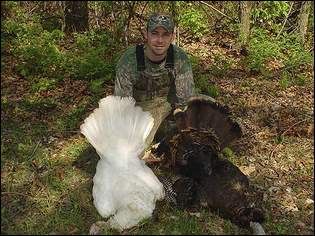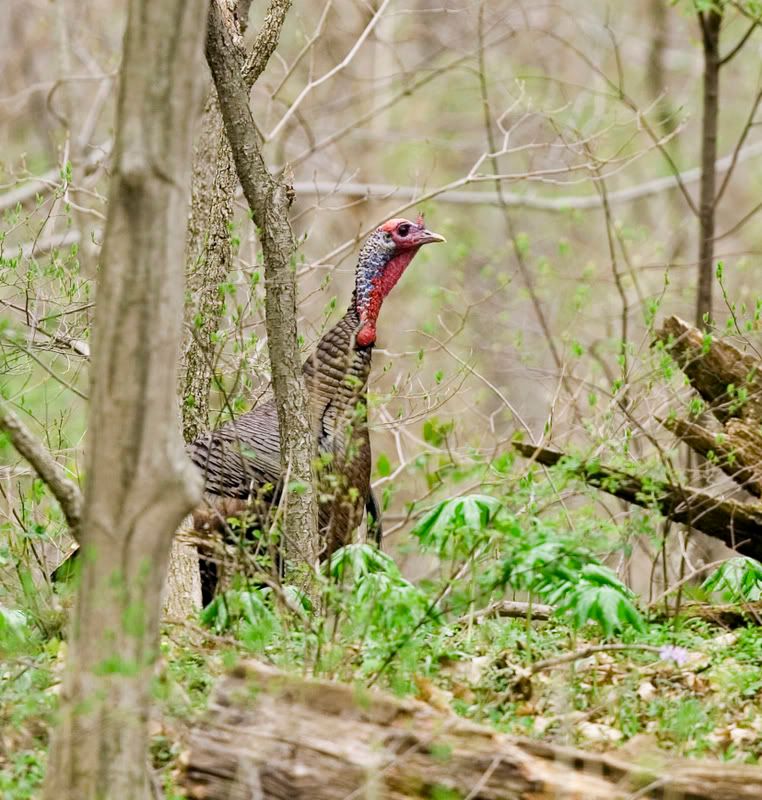Post by Woody Williams on Apr 30, 2006 18:08:19 GMT -5
Albino turkey got season off to flying start
By Gary Garth
Special to The Courier-Journal
 Matt Weeks of Louisville showed off the albino turkey he bagged near the Grayson-Hardin county line, along with a normal gobbler. (Photo courtesy of Matt Weeks)
Matt Weeks of Louisville showed off the albino turkey he bagged near the Grayson-Hardin county line, along with a normal gobbler. (Photo courtesy of Matt Weeks)
Matt Weeks has been hunting turkeys for more than half of his 28 years, having been introduced to the sport as a youngster by his father, Jerry.
He has bagged a few birds and witnessed some of the quirky things turkeys do, but he'd never seen anything quite like what he saw in the woods earlier this season.
Weeks and Kevan McCullum, both of Louisville, were hunting near the Grayson-Hardin county line. They arrived in the woods early but didn't hunt together.
"It was really foggy, and I was in the woods before daylight and set up my decoys," Weeks said.
Things were quiet until about 7:30 a.m., when Weeks heard a couple of gobblers fly down and land about 50 yards behind him.
He failed to attract those birds, but about 20 minutes later a group of jakes showed up.
Jakes, or juvenile gobblers, are the turkey version of hormone-fueled teenagers. As they often will, the juvenile birds blundered toward Meeks' decoys quietly but without much hesitation.
Meeks was familiar with jake behavior but was totally unprepared for what he saw. The bird leading the bunch was white as snow -- an albino, a turkey so rare that only a handful of hunters have ever seen one.
"About 12 jakes came in at the same time, and he was the lead bird," Meeks said. "I could see that his entire body was white."
He was momentarily stunned into inaction.
"Just for a second I thought that it might be a domesticated bird," he said. "But I knew that that was very unlikely for the single fact that he was leading the pack and he was obviously the same size and age as the other jakes."
With the albino in the lead, the birds came straight to the decoys. Meeks drew a bead on the standout bird and made a clean shot. A close inspection revealed that the young gobbler didn't have a dark feather on it. The claws were a whitish clear, but the bird lacked the pink eyes common to pure albinos.
"If it's a true albino, it should have pink eyes," said Robert Abernathy, a biologist with the National Wild Turkey Federation. "But it sounds like it definitely exhibited the traits of an albino."
Meeks didn't weigh the bird but estimated it was about 15 pounds. It had a 4-inch beard, typical of a juvenile gobbler.
He knows that it might well have been a once-in-a-lifetime encounter.
"I'd never seen an (albino turkey) in the wild and have never known anybody who'd killed one," he said.
He's not alone, however. Abernathy said the federation's South Carolina headquarters has received three calls this year from hunters who said they'd seen or killed an albino.
"That would be typical of most years," he said.
Albinoism is the result of a recessive gene.
"It happens in all animals," Abernathy said. "It's rare in the first place, and it's very rare that an albino (turkey) survives because everything keys on them. Hawks key on them. Coyotes key on them. And, of course, they're easy to see."
Weeks said he probably will have the bird mounted. He has talked with Clearwater Taxidermy, which advised him to freeze it until he decides.
Kentucky's turkey season will continue through next Sunday.
The reported harvest through yesterday was 22,340 birds, including 119 bearded hens. Turkeys with visible beards are legal. For more information go to fw.ky.gov.
Indiana's turkey season opened Wednesday and runs through May 14. For more information go to in.gov/dnr/fishwild/
www.courier-journal.com/apps/pbcs.dll/article?AID=/20060430/SPORTS09/604300452/1002/SPORTS
By Gary Garth
Special to The Courier-Journal
 Matt Weeks of Louisville showed off the albino turkey he bagged near the Grayson-Hardin county line, along with a normal gobbler. (Photo courtesy of Matt Weeks)
Matt Weeks of Louisville showed off the albino turkey he bagged near the Grayson-Hardin county line, along with a normal gobbler. (Photo courtesy of Matt Weeks)Matt Weeks has been hunting turkeys for more than half of his 28 years, having been introduced to the sport as a youngster by his father, Jerry.
He has bagged a few birds and witnessed some of the quirky things turkeys do, but he'd never seen anything quite like what he saw in the woods earlier this season.
Weeks and Kevan McCullum, both of Louisville, were hunting near the Grayson-Hardin county line. They arrived in the woods early but didn't hunt together.
"It was really foggy, and I was in the woods before daylight and set up my decoys," Weeks said.
Things were quiet until about 7:30 a.m., when Weeks heard a couple of gobblers fly down and land about 50 yards behind him.
He failed to attract those birds, but about 20 minutes later a group of jakes showed up.
Jakes, or juvenile gobblers, are the turkey version of hormone-fueled teenagers. As they often will, the juvenile birds blundered toward Meeks' decoys quietly but without much hesitation.
Meeks was familiar with jake behavior but was totally unprepared for what he saw. The bird leading the bunch was white as snow -- an albino, a turkey so rare that only a handful of hunters have ever seen one.
"About 12 jakes came in at the same time, and he was the lead bird," Meeks said. "I could see that his entire body was white."
He was momentarily stunned into inaction.
"Just for a second I thought that it might be a domesticated bird," he said. "But I knew that that was very unlikely for the single fact that he was leading the pack and he was obviously the same size and age as the other jakes."
With the albino in the lead, the birds came straight to the decoys. Meeks drew a bead on the standout bird and made a clean shot. A close inspection revealed that the young gobbler didn't have a dark feather on it. The claws were a whitish clear, but the bird lacked the pink eyes common to pure albinos.
"If it's a true albino, it should have pink eyes," said Robert Abernathy, a biologist with the National Wild Turkey Federation. "But it sounds like it definitely exhibited the traits of an albino."
Meeks didn't weigh the bird but estimated it was about 15 pounds. It had a 4-inch beard, typical of a juvenile gobbler.
He knows that it might well have been a once-in-a-lifetime encounter.
"I'd never seen an (albino turkey) in the wild and have never known anybody who'd killed one," he said.
He's not alone, however. Abernathy said the federation's South Carolina headquarters has received three calls this year from hunters who said they'd seen or killed an albino.
"That would be typical of most years," he said.
Albinoism is the result of a recessive gene.
"It happens in all animals," Abernathy said. "It's rare in the first place, and it's very rare that an albino (turkey) survives because everything keys on them. Hawks key on them. Coyotes key on them. And, of course, they're easy to see."
Weeks said he probably will have the bird mounted. He has talked with Clearwater Taxidermy, which advised him to freeze it until he decides.
Kentucky's turkey season will continue through next Sunday.
The reported harvest through yesterday was 22,340 birds, including 119 bearded hens. Turkeys with visible beards are legal. For more information go to fw.ky.gov.
Indiana's turkey season opened Wednesday and runs through May 14. For more information go to in.gov/dnr/fishwild/
www.courier-journal.com/apps/pbcs.dll/article?AID=/20060430/SPORTS09/604300452/1002/SPORTS



